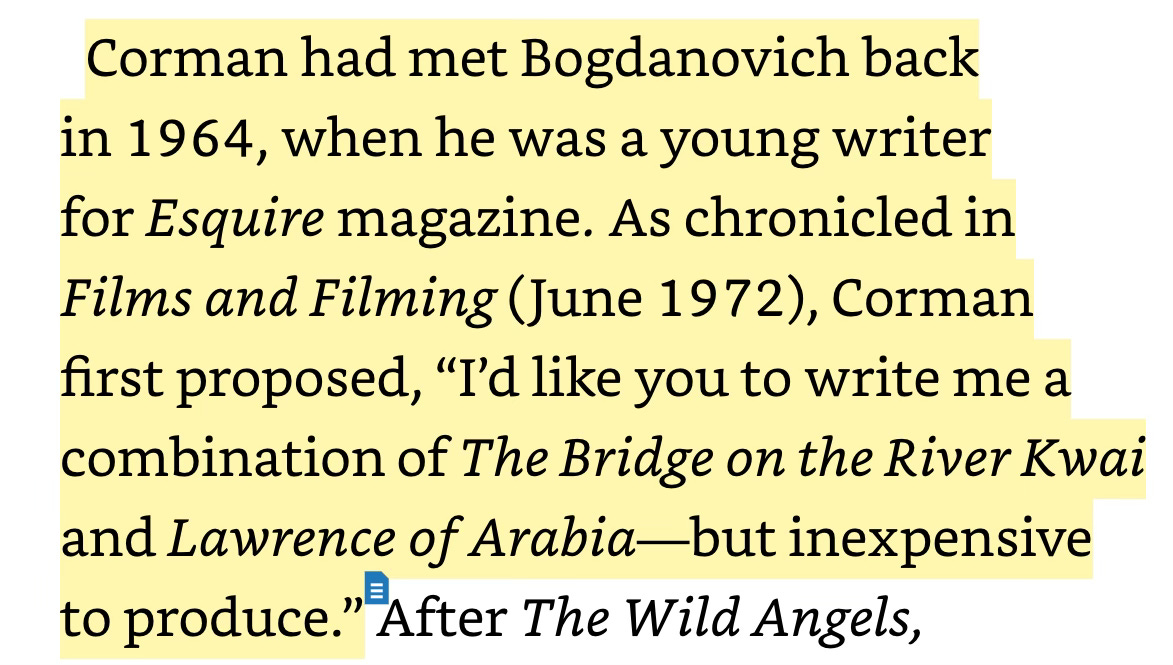Filmstack Inspirations #18
Herzog, Furiosa, Talking Heads & more
It’s day #18 of the FilmStack inspirations challenge, and my turn to take the baton. In case you’re new to this, here’s
’s original prompt:What if FilmStack challenged itself to have another author list out some of their recent inspirations each day? How many days in a row could we go? How awesome would it be if we could hit 100?
If you want to sign up yourself, just drop
a DM.Let’s get cracking. Here are eight things that have been inspiring me.
1. The Opening Credits of Blood and Black Lace (1964)
That Tango-infused theme with those neon-drenched, mannequin-like character introductions? Perfection. Even more so when you consider that the entire film was made for around $125k.
Bava is one of the GOATs at extracting atmosphere from shoestring budgets. I’ve been dipping in and out of Tim Lucas’ eyewateringly comprehensive (1125 pages!) compendium, Mario Bava: All the Colors of the Dark, which is full of fascinating tidbits on Bava’s ingenuity:
“Although [Blood & Black Lace] is one of the most sumptuous-looking Italian films of the 1960s, Cameron Mitchell remembered that the equipment at Bava’s disposal was at times preposterously primitive. ‘Do you remember that wonderful dolly shot through the fashion house? Well, our dolly on that shot was a kid’s red wagon! And when we had to do a crane type of shot, we didn’t have a crane. They literally took something like a seesaw and counterbalanced the camera by sitting crew people on the other end! But wasn’t that elegant? Didn’t that film have style?’”
2. This Reimagining of When the Levee Breaks
Whisper it, but I actually prefer this to the Led Zeppelin version. The weaving in of LZ’s Friends (from 03.02), the violin solo, the guitar breakdown, and then that glorious crescendo where it all comes together and Plant lets loose. Chef’s kiss.
I have this odd habit of imagining movie scenes to whatever I’m listening to. With this one, the climax hits just as some old legendary warrior who's been spoken about in awed tones through the film but never seen is finally revealed, doing something cool. Told you it was odd.
3. The Contradictions of Furiosa (2024)
I hold two contradictory thoughts on Furiosa (sue me).
First, barring a couple of unnecessary doses of fan service, it’s a prequel done right. Rather than retreading the same ground, it tells a different kind of story, trading the propulsive simplicity of Fury Road (2015) for a more storybook, expansive, mythic quality. It’s a different beast entirely, and all the better for it (this year, 28 Years Later pulled off something similar). If cinematic universes are still the future, then ambitious reinventions like these are the best-case scenario.
Now here’s the contradictory thought:
"The Mortifiers become the Mortiflyers."
Halfway through Furiosa, Miller decides “fuck it, let’s do 15 mins of Fury Road,” and it’s the coolest thing I’ve seen in a cinema in years. There’s plenty I could write on the video-game like escalation of the stakes, and how the set piece works because it shows character through action, but why bother? Just watch it instead:
So yes: please use franchise films to experiment with new themes and modes of storytelling rather than recycling what’s already been done.
But if you are going to recycle, do it as well as Furiosa did.
4. Talking Heads — More Songs About Buildings & Food (2025 Reissue)
Sandwiched between the magisterial sweep of Remain in Light and Fear of Music and the jagged, cocky strut of their debut, I sometimes feel that Talking Heads’ second album gets a little overlooked. It shouldn’t.
Their sound is a little less sparse than in their first album, thanks to Jerry Harrison’s beefed-out role, but it still keeps that scratchy, nervy appeal that defined the band’s early years. You can also catch some tantalising early hints of the Eno flourishes that would later culminate in Remain in Light, particularly in Stay Hungry and Found a Job, whose extended outros remain among the best moments of the band’s discography.
5. The Opening of Aguirre, the Wrath of God (1972)
The scale. The majesty. Popol Vuh’s haunting space-choir soundtrack (which, curiously, pops up again in Luca Guadagnino’s A Bigger Splash). Just the best.
Herzog does something similar in Nosferatu (1979), casually needle-dropping Wagner’s Das Rheingold while unleashing his camera on the Bavarian mountains.
This is what it’s all about.
6. Damon Albarn’s Post-Blur Career
Although Oasis won the Britpop stuff, it’s absurd how much more interesting Albarn’s post-90s career has been. Obviously, there’s Gorillaz, but I’ve been digging into some of his solo and other projects. There’s so much. Three tracks I’m enjoying at the moment:
This version of Out of Time featuring The Orchestra of Syrian Musicians.
Lady Boston; by The Good, The Bad & The Queen (supergroup featuring Albarn, Paul Simonon from The Clash, Simon Tong from The Verve and Tony Allen).
Go Back; by Tony Allen.
7. The Ambush Sequence In He Walked By Night (1948)
I’ve been on a noir tip recently (I wrote more on that here). Initially, this low-budget crime flick was passing me by, but then we hit this ambush sequence at around the halfway mark, and I did that man-leaning-forward-in-his-seat meme. Look at those shadows.
Something I find fascinating about noir is the blend between artistry, particularly the influence of German expressionist lighting, and brute financial reality. With limited budgets, the heavy use of shadow was often a practical way of hiding threadbare sets. Artistry vs resourcefulness. Are they different? Does it matter? Interesting stuff!
8. This Roger Corman Anecdote

You can’t fault the man’s ambition!



Nice selection. 💚 🥃
Here's one that I recently discovered, and it shouldn't work, but it kind of does:
https://www.youtube.com/watch?v=1M-dbmoo4og
Q